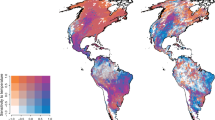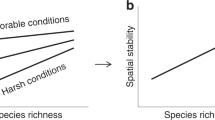Abstract
How ecosystem productivity and species richness are interrelated is one of the most debated subjects in the history of ecology1. Decades of intensive study have yet to discern the actual mechanisms behind observed global patterns2,3. Here, by integrating the predictions from multiple theories into a single model and using data from 1,126 grassland plots spanning five continents, we detect the clear signals of numerous underlying mechanisms linking productivity and richness. We find that an integrative model has substantially higher explanatory power than traditional bivariate analyses. In addition, the specific results unveil several surprising findings that conflict with classical models4,5,6,7. These include the isolation of a strong and consistent enhancement of productivity by richness, an effect in striking contrast with superficial data patterns. Also revealed is a consistent importance of competition across the full range of productivity values, in direct conflict with some (but not all) proposed models. The promotion of local richness by macroecological gradients in climatic favourability, generally seen as a competing hypothesis8, is also found to be important in our analysis. The results demonstrate that an integrative modelling approach leads to a major advance in our ability to discern the underlying processes operating in ecological systems.
This is a preview of subscription content, access via your institution
Access options
Subscribe to this journal
Receive 51 print issues and online access
$199.00 per year
only $3.90 per issue
Buy this article
- Purchase on Springer Link
- Instant access to full article PDF
Prices may be subject to local taxes which are calculated during checkout


Similar content being viewed by others
References
Willig, M. R. Biodiversity and productivity. Science 333, 1709–1710 (2011)
Adler, P. B. et al. Productivity is a poor predictor of plant species richness. Science 333, 1750–1753 (2011)
Fraser, L. H. et al. Plant ecology. Worldwide evidence of a unimodal relationship between productivity and plant species richness. Science 349, 302–305 (2015)
Grime, J. P. Competitive exclusion in herbaceous vegetation. Nature 242, 344–347 (1973)
Huston, M. A. A general hypothesis of species diversity. Am. Nat. 113, 81–101 (1979)
Tilman, D. Resource Competition and Community Structure (Princeton Univ. Press, 1982)
Taylor, D. R., Aarssen, L. W. & Loehle, C. On the relationship between r/K selection and environmental carrying capacity: a new habitat templet for plant life history strategies. Oikos 58, 239–250 (1990)
Gillman, L. N. & Wright, S. D. The influence of productivity on the species richness of plants: a critical assessment. Ecology 87, 1234–1243 (2006)
Naeem, S., Thompson, L. J., Lawler, S. P., Lawton, J. H. & Woodfin, R. M. Declining biodiversity can alter the performance of ecosystems. Nature 368, 734–737 (1994)
Tilman, D., Wedin, D. & Knops, J. Productivity and sustainability influenced by biodiversity in grassland ecosystems. Nature 379, 718–720 (1996)
Huston, M. A. Hidden treatments in ecological experiments: re-evaluating the ecosystem function of biodiversity. Oecologia 110, 449–460 (1997)
Grime, J. P. Biodiversity and ecosystem function: the debate deepens. Science 277, 1260–1261 (1997)
Cardinale, B. J. et al. Biodiversity loss and its impact on humanity. Nature 486, 59–67 (2012)
Tilman, D., Reich, P. B. & Isbell, F. Biodiversity impacts ecosystem productivity as much as resources, disturbance, or herbivory. Proc. Natl Acad. Sci. USA 109, 10394–10397 (2012)
Hawkins, B. A. et al. Energy, water, and broad-scale geographic patterns of species richness. Ecology 84, 3105–3117 (2003)
Pärtel, M., Zobel, K., Laanisto, L., Szava-Kovats, R. & Zobel, M. The productivity-diversity relationship: varying aims and approaches. Ecology 91, 2565–2567 (2010)
Grime, J. P. Plant Strategies and Vegetation Processes (John Wiley, 1979)
Chase, J. M. & Leibold, M. A. Spatial scale dictates the productivity-biodiversity relationship. Nature 416, 427–430 (2002)
Scheiner, S. M. & Jones, S. Diversity, productivity and scale in Wisconsin vegetation. Evol. Ecol. Res. 4, 1097–1117 (2002)
Waide, R. et al. The relationship between productivity and species richness. Annu. Rev. Ecol. Syst. 30, 257–300 (1999)
Grace, J. B. The factors controlling species density in herbaceous plant communities: an assessment. Perspect. Plant Ecol. Evol. Syst. 2, 1–28 (1999)
Mittelbach, G. G. et al. What is the observed relationship between species richness and productivity? Ecology 82, 2381–2396 (2001)
Whittaker, R. J. Meta-analyses and mega-mistakes: calling time on meta-analysis of the species richness-productivity relationship. Ecology 91, 2522–2533 (2010)
Borer, E. T. et al. Herbivores and nutrients control grassland plant diversity via light limitation. Nature 508, 517–520 (2014)
Schmid, B. The species richness–productivity controversy. Trends Ecol. Evol. 17, 113–114 (2002)
Loreau, M., Naeem, S. & Inchausti, P. Biodiversity and Ecosystem Functioning: Synthesis and Perspectives (Oxford Univ. Press, 2002)
Cardinale, B. J., Bennett, D. M., Nelson, C. E. & Gross, K. Does productivity drive diversity or vice versa? A test of the multivariate productivity-diversity hypothesis in streams. Ecology 90, 1227–1241 (2009)
Scherber, C. et al. Bottom-up effects of plant diversity on multitrophic interactions in a biodiversity experiment. Nature 468, 553–556 (2010)
Grace, J. B. et al. Guidelines for a graph-theoretic implementation of structural equation modeling. Ecosphere 3, art73 (2012)
Grace, J. B., Adler, P. B., Stanley Harpole, W., Borer, E. T. & Seabloom, E. W. Causal networks clarify productivity–richness interrelations, bivariate plots do not. Funct. Ecol. 28, 787–798 (2014)
Grace, J. B., Anderson, T. M., Olff, H. & Scheiner, S. M. On the specification of structural equation models for ecological systems. Ecol. Monogr. 80, 67–87 (2010)
Regan, H. M., Colyvan, M. & Burgman, M. A. A taxonomy and treatment of uncertainty for ecology and conservation biology. Ecol. Appl. 12, 618–628 (2002)
Borer, E. T. et al. Finding generality in ecology: a model for globally distributed experiments. Methods Ecol. Evol. 5, 65–73 (2014)
Gelman, A. & Hill, J. Data Analysis Using Regression and Multilevel/Hierarchical Models (Cambridge Univ. Press, 2007)
Chao, A. Estimating the population size for capture-recapture data with unequal catchability. Biometrics 43, 783–791 (1987)
Chao, A. & Jost, L. Coverage-based rarefaction and extrapolation: standardizing samples by completeness rather than size. Ecology 93, 2533–2547 (2012)
Lauenroth, W., Hunt, H., Swift, D. & Singh, J. Estimating aboveground net primary production in grasslands: a simulation approach. Ecol. Modell. 33, 297–314 (1986)
Oesterheld, M. & McNaughton, S. J. in Methods in Ecosystem Science (eds Sala, O. E., Jackson, R. B., Mooney, H. A. & Howarth, R. W. ) Ch. 10, 151–157 (Springer, 2000)
Muldavin, E. H., Moore, D. I., Collins, S. L., Wetherill, K. R. & Lightfoot, D. C. Aboveground net primary production dynamics in a northern Chihuahuan Desert ecosystem. Oecologia 155, 123–132 (2008)
Hijmans, R., Cameron, S., Parra, J., Jones, P. & Jarvis, A. WorldClim, version 1.3 (Univ. California, Berkeley, 2005)
Grace, J. B. & Bollen, K. A. Representing general theoretical concepts in structural equation models: the role of composite variables. Environ. Ecol. Stat. 15, 191–213 (2008)
Grace, J. B., Scheiner, S. M. & Schoolmaster, D. R. Jr in Ecological Statistics (eds Fox, G. A., Negrete-Yankelevich, S. & Sosa, V. J.) Ch. 8, 168–199 (Oxford Univ. Press, 2015)
R Development Core Team. R: a language and environment for statistical computing (R Foundation for Statistical Computing, 2012)
Rosseel, Y., Oberski, D., Byrnes, J., Vanbrabant, L. & Savalei, V. lavaan: latent variable analysis (software ) (R Foundation for Statistical Computing, 2013)
Oberski, D. lavaan.survey: an R package for complex survey analysis of structural equation models. J. Stat. Softw. 57, 1–27 (2014)
Acknowledgements
J.B.G. was supported by the US Geological Survey Ecosystems and Climate and Land use Change Programs. This work uses data from the Nutrient Network (http://nutnet.org) experiment, funded at the site scale by individual researchers. Coordination and data management were supported by funding to E.T.B. and E.W.S. from the National Science Foundation (NSF) Research Coordination Network (NSF-DEB-1042132) and Long Term Ecological Research (NSF-DEB-1234162 to Cedar Creek LTER) programs and the UMN Institute on the Environment (DG-0001-13). The Minnesota Supercomputer Institute hosts project data. The use of trade, firm, or product names is for descriptive purposes only and does not imply endorsement by the US Government. Support for site-level activities is acknowledged in the Supplementary Information. We thank D. Laughlin for comments on the manuscript.
Author information
Authors and Affiliations
Contributions
E.W.S., E.T.B., W.S.H. and E.M.L. are Nutrient Network coordinators. J.B.G. and T.M.A. developed and framed the research questions. T.M.A., E.W.S., E.T.B., P.B.A., W.S.H., Y.H., H.H., J.D.B., Y.M.B., M.J.C., E.I.D., K.F.D., P.A.F., J.F., D.S.G., A.H., J.M.H.K., A.S.M., B.A.M., J.W.M., J.L.O., S.M.P. and M.D.S. collected data used in this analysis. T.M.A. assembled the data and performed initial analyses. J.B.G. analysed the data and wrote the paper with contributions and input from all authors.
Corresponding author
Ethics declarations
Competing interests
The authors declare no competing financial interests.
Extended data figures and tables
Extended Data Figure 1 Structural equation meta-model showing hypothesized probabilistic expectations based on literature related to the productivity–diversity debate.
Solid lines represent expected positive effects, dashed lines represent expected negative effects. Literature and meta-model development are discussed in the Supplementary Information. Specific implementations of this generalized model for particular cases will probably differ in detail as appropriate for the situation and available data.
Supplementary information
Supplementary Information
This file contains Supplementary Materials and Methods, Supplementary Tables 1-2, Supplementary References and Supplementary Acknowledgements. (PDF 740 kb)
Supplementary Data 1
This file contains the computer code that accompanies the paper. (TXT 29 kb)
Supplementary Data 2
This file contains the plot-level data set. (CSV 222 kb)
Supplementary Data 3
This file contains the site-level dataset. (CSV 9 kb)
PowerPoint slides
Source data
Rights and permissions
About this article
Cite this article
Grace, J., Anderson, T., Seabloom, E. et al. Integrative modelling reveals mechanisms linking productivity and plant species richness. Nature 529, 390–393 (2016). https://doi.org/10.1038/nature16524
Received:
Accepted:
Published:
Issue Date:
DOI: https://doi.org/10.1038/nature16524
This article is cited by
-
Diversity of forest structures important for biodiversity is determined by the combined effects of productivity, stand age, and management
Ambio (2024)
-
Effects of plant diversity on productivity strengthen over time due to trait-dependent shifts in species overyielding
Nature Communications (2024)
-
The association between comorbid body dysmorphic disorder and depression: moderation effect of age and mediation effect of body mass index and body image among Pakistani students
Middle East Current Psychiatry (2023)
-
Relationships between species richness and biomass production are context dependent in grasslands differing in land-use and seed addition
Scientific Reports (2023)
-
Tree diversity increases decadal forest soil carbon and nitrogen accrual
Nature (2023)
Comments
By submitting a comment you agree to abide by our Terms and Community Guidelines. If you find something abusive or that does not comply with our terms or guidelines please flag it as inappropriate.



